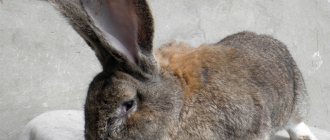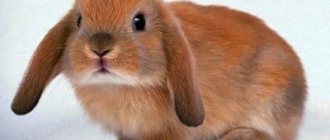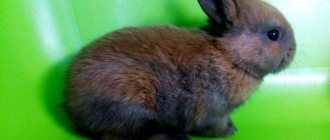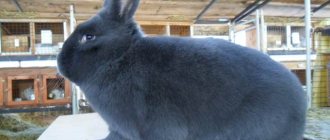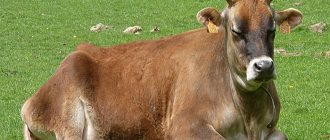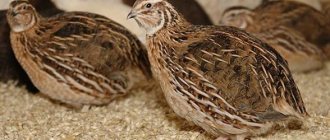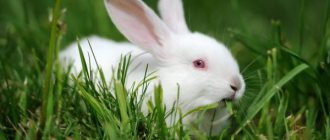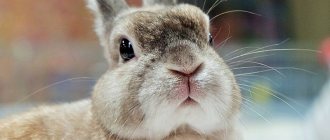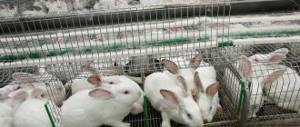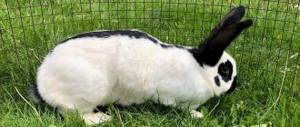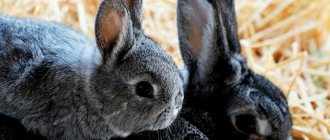Universal breeds of rabbits are often distinguished by their unpretentiousness and ease of keeping and feeding. In addition, such animals provide a sufficient amount of healthy and tasty meat, as well as fur for making clothes and accessories. In this regard, the Black-brown rabbit breed is noteworthy, which is the result of long-term work by domestic breeders. In addition, its representatives can participate in exhibitions. But in order for breeding a black-brown rabbit to be as profitable as possible, it is important to pay attention to some of the nuances of choosing and keeping animals. This article will tell you what problems may arise in these processes.
Origin
Rabbits of the Black-brown breed were bred in the USSR in the mid-twentieth century on the Biryulinsky state farm in the Republic of Tatarstan . The variety was obtained as a result of complex multi-stage selection by crossing large breeds such as Vienna Blue, White Giant, Chinchilla and Flandre. The goal of the breeders was to register a meat-and-skin breed that would retain all the best qualities of the source material.
Today, the Black and Brown rabbit breed looks somewhat different than at the time of breeding. This is because it has been improved over time by adding new bloodlines.
Black and brown rabbits were bred in the Republic of Tatarstan of the former USSR
Description and breed standard of the black-brown rabbit
Rabbits of the black-brown breed are large. The weight that purebred males can have reaches 7 kg, but on average it fluctuates around 5 kg. These are powerful, well-dressed animals with a somewhat elongated body and wide back and chest. The head is proportional, with a noticeable dewlap, crowned with long ears. Both the front and hind legs are long, certainly straight, with well-developed muscles.
The fur is medium length, very thick. There are about 50 down hairs per guard hair; the wool density ranges from 19 to 28 thousand hairs per square centimeter. The color of the undercoat is blue, the awn has an uneven color. The rosette has a light center and darkening towards the edge. The covert hair rises above the downy hair and forms a black veil over the entire body. The uneven distribution of guard hairs and undercoat along the body makes the back of the rabbit darker than the sides.
The breed standard includes rabbits that have the correct coat color and structure, large bones, and a wide, rounded croup. A purebred rabbit should have ears up to 18 cm long, a body of 60-62 cm, and a girth behind the shoulder blades of 37 cm.
The following are considered vices:
- underdeveloped skeleton;
- short body less than 50 cm long;
- gibbosity;
- narrow chest with a girth of less than 25 cm;
- drooping or stubby croup;
- clubfoot, crooked and thin paws;
- the weight of eight-month-old young animals is less than 3 kg, adults less than 4 kg;
- the presence of tufts of white guard hairs;
- presence of pronounced gray hair;
- rare fur;
- light color, brown veil.
Breed characteristics
The black-brown breed of rabbits has unique characteristics and standards, thanks to which animals can be selected for further cultivation and breeding. Among them:
- strong body, elongated and slender (up to seventy centimeters);
- convex large breasts;
- large developed head (up to nineteen centimeters);
- Brown eyes;
- uneven color, characteristic black-brown tint.
The body weight of an adult animal is five to seven kilograms. Rabbit fur is thick and soft, great for making clothing.
Black-brown rabbits have a massive head with long ears
When choosing animals for breeding, you need to pay attention to the following possible defects:
- chopped off butt;
- narrow chest;
- weak undeveloped skeleton;
- short crooked limbs;
- hunched spine;
- short body.
Animals with such defects develop poorly and do not maintain body weight. In addition, they cannot produce high-quality offspring, which means the losses can be quite large.
Defective rabbits are developmentally delayed
Standards, breed description and photographs
A pair of black-brown rabbits in a cage.
A healthy female black-brown rabbit.
The exterior of Black-brown rabbits has several characteristic features:
- strong constitution, slender and elongated body, the length of which does not exceed 60-70 cm;
- deep wide chest, the circumference of which varies between 34-39 cm;
- pronounced dewlap, straight and wide back, straight thick legs with well-developed muscles;
- large head, rather long ears (about 17-19 cm), brown eyes;
- uneven coat color and thick fur of a characteristic black-brown color.
In terms of wool density, rabbits of this breed are in one of the leading positions in comparison with other species. The black-brown color is obtained due to the fact that the guide hairs have a shiny black color, with a slight silver-gray tint at the base, and the guard hairs are unevenly colored. In the lateral parts of the hair it has a bluish-gray color, turning into a yellow-brown tint and then black. The undercoat is blue in color, and the covert hair, rising above the down coat, forms a kind of black veil over the entire body.
Walking the Black Brown Rabbit.
The weight of an adult rabbit reaches 3.6-6.5 kg. The average weight of baby rabbits is about 80 g. With proper nutrition and care, by the age of three months they can reach 2.5 -3 kg.
Gain rates vary at certain periods of life:
- up to 30 days – 0.6 kg;
- up to 60 days – 1.25-1.6 kg;
- up to 90 days – 1.55-2.3 kg;
- up to 120 days – 1.85-3.1 kg;
- up to 150 days – 2.35-4 kg;
- up to 180 days – 2.75-4.5 kg;
- up to 210 days – 3.15-4.9 kg;
- up to 240 days – 3.45-5.2 kg;
- up to 270 – 3.75-5.4 kg.
The quality of fur of Black-brown animals is at its best: per 1 sq. cm of skin there are from 19 to 28 thousand hairs, and on one guard hair there are up to 50 downy hairs.
Rabbits of this breed have an inquisitive and cheerful character, but, despite their mobility, they are reluctant to come into contact with humans.
Breed productivity
An adult female rabbit is ready to mate by the age of seven months. For one birth, she brings seven to ten rabbits weighing eighty to one hundred grams. A month after birth, with proper feeding, baby rabbits weigh about six hundred grams; by the age of about six months, their weight reaches three to five kilograms. This material will tell you about the maintenance and care of the Belgian breed of cows.
Rabbits have thick, high-density fur. Thanks to this quality and original coloring, fur is very popular and is widely used in the manufacture of clothing, accessories and decorative items.
In one litter, a female rabbit brings about 10 babies.
Black and brown rabbits. Description of the breed
These rabbits are a fairly large species.
The live weight of a purebred male reaches seven kilograms, and the average is five.
These animals are distinguished by a powerful physique, dense and thick coat, a slightly elongated body, as well as a wide chest and powerful back. Well defined dewlap. The size of the head is proportional to the rest of the body. The ears are long and erect. Limbs – straight, long, with well-developed muscles.
The fur cover is of increased density, the length of the wool fibers is average. The structure of the fur is of high quality (for one awn hair there are approximately 50 downy hairs). The density indicator varies from 19 to 28 thousand hairs per square centimeter of skin.
The undercoat is blue, the color of the guard hairs is uneven (light center and darker edges). The uneven distribution of the hair and undercoat on the body makes the side surface of the back darker than the main color.
The breed standard requirements for animals are: correct structure and color of fur, large and powerful bones, wide, rounded croup.
The length of the ears of a purebred rabbit should not exceed 18 centimeters, body length - from 60 to 62 centimeters, chest girth - 37 centimeters.
Deficiencies that serve as grounds for rejection include:
- insufficient bone development;
- body length is less than half a meter;
- hunched back;
- chest circumference is less than 25 centimeters;
- saggy or stubby butt;
- crooked, clubbed or thin limbs;
- the live weight of a rabbit at eight months is less than that of an adult - less than four kilograms;
- the presence of white tufts of guard hairs in the coat;
- pronounced gray hair;
- insufficient fur density (sparse hair);
- light colors;
- the presence of a brown veil.
Maintenance and care
Black-brown rabbits, unlike many other breeds, are perfectly adapted to harsh climates, so they can be raised in almost any region of Russia. They can be kept in outdoor cages even in the cold season, but the premises for them must be spacious enough, since standard cage sizes will cause discomfort. It is recommended that each individual have at least half a meter of room. Read about drinking bowls for rabbits at this link.
It is best to make the floor in the cages solid, since the mesh can damage the rabbits' paws. Meanwhile, the presence of bedding is mandatory. It needs to be replaced regularly. Preventive cleanings and treatments with antiparasitic and bactericidal drugs will also be useful. Read about keeping and caring for Pietrain piglets here.
Black-brown rabbits are able to adapt to any weather conditions, so they can be kept in cage buildings outside even in winter
In winter, it is recommended to place the cages facing south or southeast so that they warm up evenly. However, in the warm season, animals should not be allowed to be stuffy or exposed to direct sunlight.
Pits are also suitable for raising rabbits. It is important that they are sufficiently insulated and strengthened from the inside. Shared premises may be suitable, but in this case it may be almost impossible to control mating. In addition, there is a danger of rapid spread of infection if one individual is infected.
Keeping rabbits in a pit
Black-brown rabbit description of the breed
So, a rabbit belonging to this breed has several features that distinguish it:
- uneven distribution of color throughout the coat;
- the highest density of hair.
This breed is one of the first in terms of wool density. At the guide hairs, a shiny shade of a dark tone predominates; at the bases, a lighter and slightly bluish tone predominates. The black-brown rabbit has a rather unusual and uneven color on the guard hairs on the sides - a yellowish color with slightly brown tints.
The standard weight of an adult animal is from 4.5 to 7 kg. Adult, sexually mature females are smaller in size compared to males (up to 5.5 kg). The rabbit's body has a rough and strong build, with fairly well-developed bones. The body is powerful and massive, elongated, sometimes the length reaches 70 centimeters. The described rabbit's chest is wide in circumference behind the shoulder blades, and has a sagging belly. The back is long, wide, level with a developed sacral lobe. The croup is wide and rounded. The paws are short, thick and straight. The head has a rounded and large shape with well-developed wide and dense ears, the length of which reaches 17 centimeters. This breed is also distinguished by its friendly and inquisitive character, but even so, they are not very willing to make contact with people.
Feeding
The diet of Black-brown rabbits differs little from the standard menu of other meat-and-skin breeds. The most important thing in feeding animals is the correct ratio of lipids, carbohydrates and proteins in food, as well as a sufficient amount of vitamins and minerals. So, the basis of the diet should be the following products:
- concentrates and combined feeds in dry form and in mash;
- grain crops (corn, barley, oats);
- fresh and dry greens , hay;
- root vegetables (boiled and raw potatoes, beets, carrots).
Rabbits can be given ready-made feed
Animals must be fed twice a day. Feeding dry pine branches and rough food to grind teeth is a necessary measure. It is also important that clean water is constantly present in the cells. Its deficiency can lead to constipation and problems with bowel movements. This article will tell you about diarrhea in rabbits.
It is best to fatten in the spring and summer, when there is enough green feed. To gain weight, it is best to prepare mixed feed and mash. Boiled potatoes are also recommended for regular serving.
Vitamin and mineral complex for rabbits is an important element of their diet
It is recommended to soak the grain before serving. In this form, food will be better absorbed and will not lead to bloating and poor digestion.
Breeding
Female rabbits reach sexual maturity at seven to eight months, while males are ready to mate at four months. Females are good mothers and can bear offspring almost all year round. The survival rate and disease resistance of rabbits is high.
Rabbits can be weaned from their mother a month after birth. After this, they must be placed in a separate warm room. To prevent diseases, young animals should be vaccinated with VGBK. It is also recommended that rabbits and adults be given chamomile infusion or a weak solution of potassium permanganate once or twice a week.
It is recommended to periodically update the offspring to prevent closely related relationships
It is necessary to periodically update the offspring to prevent closely related relationships. This rule applies to all breeds of rabbits. Black and brown representatives can be crossed with breeds such as Risen and Dwarf ram to obtain more meat.
It is recommended to purchase rabbits for breeding at the age of three months. By this time they will be sufficiently developed to examine their appearance and determine the possible presence of defects. Body weight by three months should be one and a half to two kilograms.
Finding purebred black and brown rabbits is quite difficult. They are practically never found on ordinary farms, so it is recommended to purchase young animals for raising and restocking only in specialized farms in Tatarstan.
How to buy a purebred black and brown rabbit
First of all, never buy them secondhand. Since this breed is not widespread, there is a high risk of running into a crossbreed. Buy animals only from serious and trusted breeders.
Thoroughbred rabbits are sold by the above-mentioned Research Institute of Fur Breeding and Rabbit Breeding. In addition, addresses of breeding farms can be found on specialized forums. When purchasing young animals, you should remember that these animals are born completely black, and the characteristic silver-brown color appears at four to five months.
At a younger age, evaluate whether the baby rabbit meets the breed standard or not,
A humpbacked silhouette, poorly developed bones, a saggy butt, crooked thin legs and insufficiently long ears are the main signs that a given rabbit does not meet the breed requirements.

